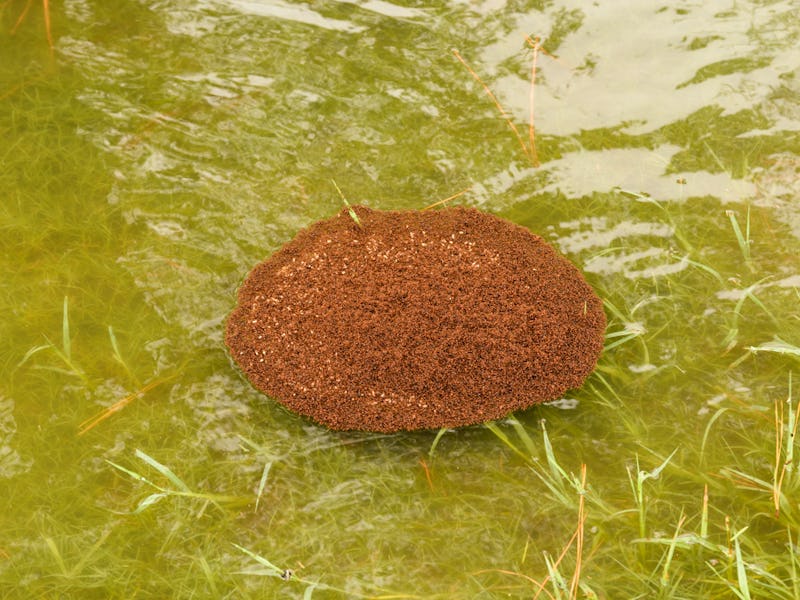How the Houston Flood Supercharged Rafts of Pissed-Off Fire Ants
'From the ant's point of view, it's all a threat.'

Everything is bigger in Texas, especially the massive rafts of fire ants floating in the wake of Hurricane Harvey. These aren’t your typical congregations of fire ants, either. Nature, almost comedic in its cruelty, has made it so their painful, blistering stings are much more potent than usual.
Solenopsis invicta ants, commonly known as red imported fire ants (or “spicy boys” in some circles), are native to South America but have spread throughout the southern United States, thanks to a number of adaptations that make them exceptionally well-suited to thrive in environments ranging from arid sand to literal floods.
See below: Robot Ants
One of their most terrifying adaptations, as Texans and horrified internet users have recently discovered, is their uncanny ability to link together and form a raft in which individual ants take turns above water. This ensures a colony’s survival in the event of a flood, and, oh yeah, it also creates floating nightmares.
“The average venom per sting delivered by S. invicta workers was around 87 percent greater, a bit short of double the dose, while rafting than when defending from the relative safety of their nests in the ground,” Kevin Haight, a research specialist at Arizona State University, tells Inverse.
Floating rafts of Solenopsis invicta fire ants are even more venomous than usual.
Haight is referring to the research he published in 2006 in the journal Insectes Sociaux, which showed that these invasive ants, known for their painful stings, become even more hazardous during flood conditions.
In an experiment, Haight compared fire ants’ venom output before and after colony rafting by using a latex dummy hand to measure venom output and sting frequency in a colony before and after he flooded it. The difference was clear, and Haight says it made a lot of sense from a survival adaptation perspective. The ant colony, he says, is never more vulnerable than it is while rafting.
“They are exposed on all sides and they cannot flee,” he wrote. “They are even potential prey for animals that would not otherwise be threats. For example, rafting colonies on ponds or rivers may make tempting targets for fish or other aquatic predators.”
One fire ant bite is painful enough, but if you wander into a whole raft of them, you could get a shitload of these pustules.
Unfortunately for humans, potential predators and clumsy bystanders don’t look any different to ants, so if you touch an ant raft, you’ll probably get stung.
“From the ant’s point of view it’s all a threat: death by being crushed or scattered, or death by being consumed,” says Haight.
For most people, fire ant stings cause painful swelling and pustules, but for allergic individuals — between one and six percent of people — it can cause an anaphylactic response, which can be fatal if untreated. With that in mind, Texans and anyone in flooded areas should exercise extreme caution. This is especially true when considering how the unique conditions of a flood could expose a person to way more ants than they might expect in a single encounter.
“When ants are defending their nests in the ground, a person stepping on them will probably be protected by shoes, pants, etc., potentially reducing the number of stings they receive to the skin,” says Haight.
“However, in a flood situation, a person may be more likely to have bare skin exposed to the ants, or to have body parts other than feet and legs receive stings. In addition to all this, when the ants are rafting, their colony is both entirely exposed and highly concentrated, so any threat they encounter will have the whole colony to deal with rather than just the portion of the work force that happens to be near the ground surface as when an anthill is stepped on.”
In the floods that followed Harvey, ant researchers and laypeople have taken to Twitter to express their disbelief at the size of the ant rafts floating around Texas.
Alex Wild, a curator of entomology at the University of Texas at Austin, who is known for his ant photography, expressed his dismay at the photo above.
The best thing you can do to protect yourself, says Haight, is to wear long sleeves and pants, even though it might be uncomfortable. But, of course, the best thing to do is steer totally clear.
“The rafting ants will attempt to climb up anything solid they encounter, so people should be cautious and keep their distance if a raft is spotted.”